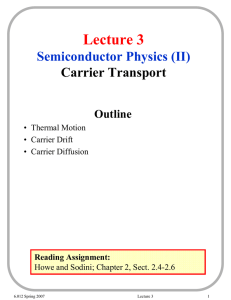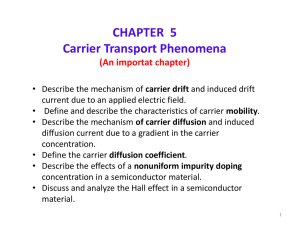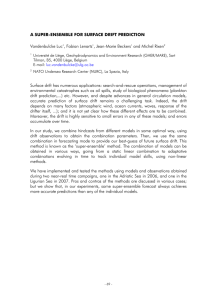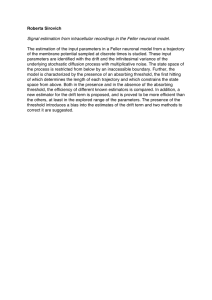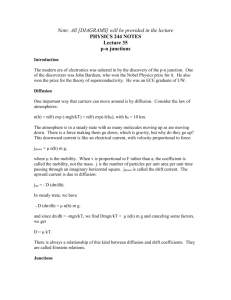Lecture 3 Semiconductor Physics (II) Carrier Transport Outline
advertisement
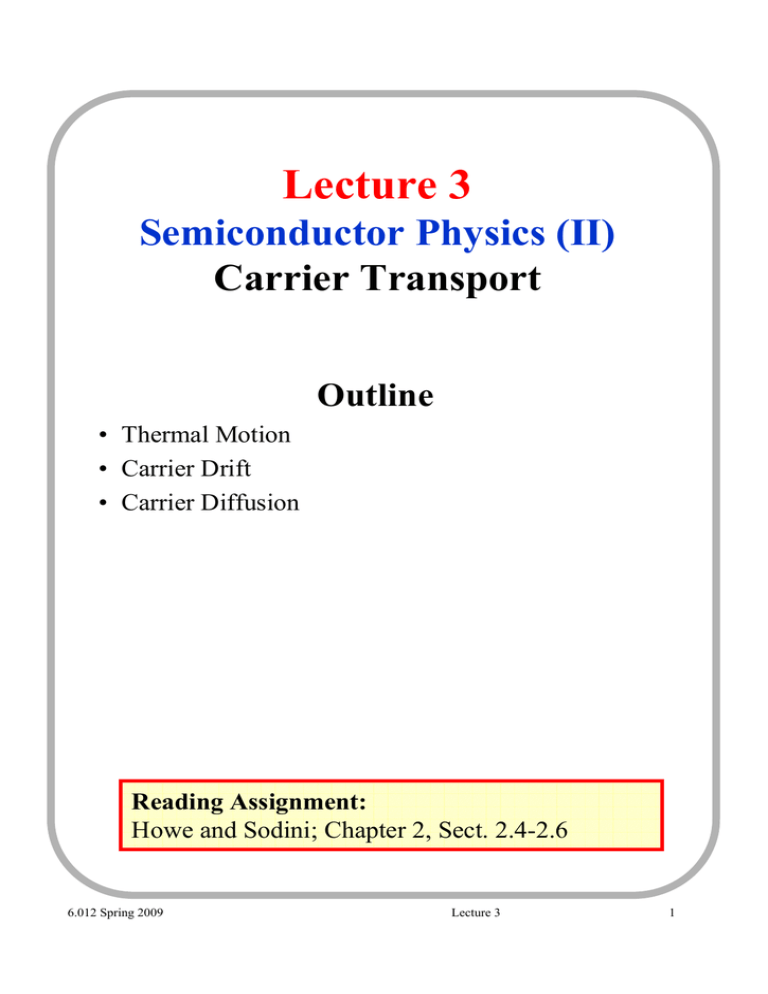
Lecture 3 Semiconductor Physics (II) Carrier Transport Outline • Thermal Motion • Carrier Drift • Carrier Diffusion Reading Assignment: Howe and Sodini; Chapter 2, Sect. 2.4-2.6 6.012 Spring 2009 Lecture 3 1 1. Thermal Motion In thermal equilibrium, carriers are not sitting still: • Undergo collisions with vibrating Si atoms (Brownian motion) • Electrostatically interact with each other and with ionized (charged) dopants Characteristic time constant of thermal motion: ⇒ mean free time between collisions τ c ≡ collison time [s] In between collisions, carriers acquire high velocity: −1 v th ≡ thermal velocity [cms ] …. but get nowhere! 6.012 Spring 2009 Lecture 3 2 Characteristic length of thermal motion: λ ≡ mean free path [cm] λ = v thτ c Put numbers for Si at room temperature: τ c ≈ 10 −13 7 s vth ≈ 10 cms −1 ⇒ λ ≈ 0.01 µm For reference, state-of-the-art production MOSFET: Lg ≈ 0.1 µm ⇒ Carriers undergo many collisions as they travel through devices 6.012 Spring 2009 Lecture 3 3 2. Carrier Drift Apply electric field to semiconductor: E ≡ electric field [V cm-1] ⇒ net force on carrier F = ±qE E Between collisions, carriers accelerate in the direction of the electrostatic field: qE v(t) = a • t = ± t mn,p 6.012 Spring 2009 Lecture 3 4 But there is (on the average) a collision every τc and the velocity is randomized: net velocity� in direction � of field τc time The average net velocity in direction of the field: v = vd = ± qE qτ c τc = ± E 2mn,p 2mn,p This is called drift velocity [cm s-1] Define: qτ c 2 −1 −1 µn, p = ≡ mobility [cm V s ] 2mn,p Then, for electrons: v dn = − µn E and for holes: 6.012 Spring 2009 v dp = µp E Lecture 3 5 Mobility - is a measure of ease of carrier drift • If τc ↑, longer time between collisions ⇒ µ ↑ • If m ↓, “lighter” particle ⇒ µ ↑ At room temperature, mobility in Si depends on doping: 1400 1200 electrons mobility (cm2/Vs) 1000 800 600 holes 400 200 0 1013 1014 1015 1016 1017 1018 Nd + Na total dopant concentration (cm−3) 1019 1020 • For low doping level, µ is limited by collisions with lattice. As Temp ->INCREASES; µ-> DECREASES • For medium doping and high doping level, µ limited by collisions with ionized impurities • Holes “ heavier” than electrons – For same doping level, µn > µp 6.012 Spring 2009 Lecture 3 6 Drift Current Net velocity of charged particles ⇒ electric current: Drift current density ∝ carrier drift velocity ∝ carrier concentration ∝ carrier charge Drift current densities: drift Jn = −qnv dn = qnµ n E drift J p = qpv dp = qpµ p E Check signs: E vdn E vdp - + Jpdrift Jndrift x x 6.012 Spring 2009 Lecture 3 7 Total Drift Current Density : J drift drift = Jn drift + Jp ( ) = q nµ n + pµ p E Has the form of Ohm’s Law J =σE = E ρ Where: σ ≡ conductivity [Ω-1 • cm-1] ρ ≡ resistivity [Ω • cm] Then: σ= 6.012 Spring 2009 1 ( = q nµ n + pµ p ρ ρ Lecture 3 ) 8 Resistivity is commonly used to specify the doping level • In n-type semiconductor: • In p-type semiconductor: 1 ρn ≈ qN d µn 1 ρp ≈ qN aµ p 1E+4 Resistivity (ohm.cm) 1E+3 1E+2 1E+1 p-Si 1E+0 n-Si 1E-1 1E-2 1E-3 1E-4 1E+12 1E+13 1E+14 1E+15 1E+16 1E+17 1E+18 1E+19 1E+20 1E+21 Doping (cm-3) 6.012 Spring 2009 Lecture 3 9 Numerical Example: Si with Nd = 3 x 1016 cm-3 at room temperature µ n ≈ 1000 cm 2 / V • s ρn ≈ 0.21Ω • cm n ≈ 3X1016 cm −3 Apply E = 1 kV/cm vdn ≈ −10 6 cm / s << vth E drift Jn ≈ qnvdn = qnµ n E = σ E = ρ Jndrift ≈ 4.8 ×10 3 A / cm2 Time to drift through L = 0.1 µm fast! 6.012 Spring 2009 L td = = 10 ps vdn Lecture 3 10 3. Carrier Diffusion Diffusion = particle movement (flux) in response to concentration gradient n x Elements of diffusion: • A medium (Si Crystal) • A gradient of particles (electrons and holes) inside the medium • Collisions between particles and medium send particles off in random directions – Overall result is to erase gradient 6.012 Spring 2009 Lecture 3 11 Fick’s first lawKey diffusion relationship Diffusion flux ∝ - concentration gradient Flux ≡ number of particles crossing a unit area per unit time [cm-2 • s-1] For Electrons: Fn = −Dn For Holes: Fp = −Dp dn dx dp dx 2 s-1] Dn ≡ Dp ≡ hole diffusion coefficient [cm2 s-1] D measures the ease of carrier diffusion in response to a concentration gradient: D ↑ ⇒ Fdiff ↑ D limited by vibration of lattice atoms and ionized dopants. 6.012 Spring 2009 Lecture 3 12 Diffusion Current Diffusion current density =charge × carrier flux dn diff Jn = qDn dx dp diff J p = −qD p dx Check signs: n p Fn Fp Jpdiff Jndiff x x 6.012 Spring 2009 Lecture 3 13 Einstein relation At the core of drift and diffusion is same physics: collisions among particles and medium atoms ⇒ there should be a relationship between D and µ Einstein relation [will not derive in 6.012] D kT = µ q In semiconductors: Dn µn = kT q Dp µp = kT/q ≡ thermal voltage At room temperature: kT ≈ 25mV q For example: for Nd = 3 x 1016 cm-3 µn ≈ 1000 cm2 / V • s ⇒ Dn ≈ 25cm 2 / s µ p ≈ 400 cm 2 / V • s ⇒ D p ≈ 10 cm 2 / s 6.012 Spring 2009 Lecture 3 14 Total Current Density In general, total current can flow by drift and diffusion separately. Total current density: dn dx dp = qpµ pE − qD p dx diff J n = J drift + J = qnµ n E + qD n n n drift Jp = Jp diff + Jp J total = J n + J p 6.012 Spring 2009 Lecture 3 15 What did we learn today? Summary of Key Concepts • Electrons and holes in semiconductors are mobile and charged – ⇒ Carriers of electrical current! • Drift current: produced by electric field drift J drift ∝E J dφ ∝ dx • Diffusion current: produced by concentration gradient diffusion J dn dp ∝ , dx dx • Diffusion and drift currents are sizeable in modern devices • Carriers move fast in response to fields and gradients 6.012 Spring 2009 Lecture 3 16 MIT OpenCourseWare http://ocw.mit.edu 6.012 Microelectronic Devices and Circuits Spring 2009 For information about citing these materials or our Terms of Use, visit: http://ocw.mit.edu/terms.
